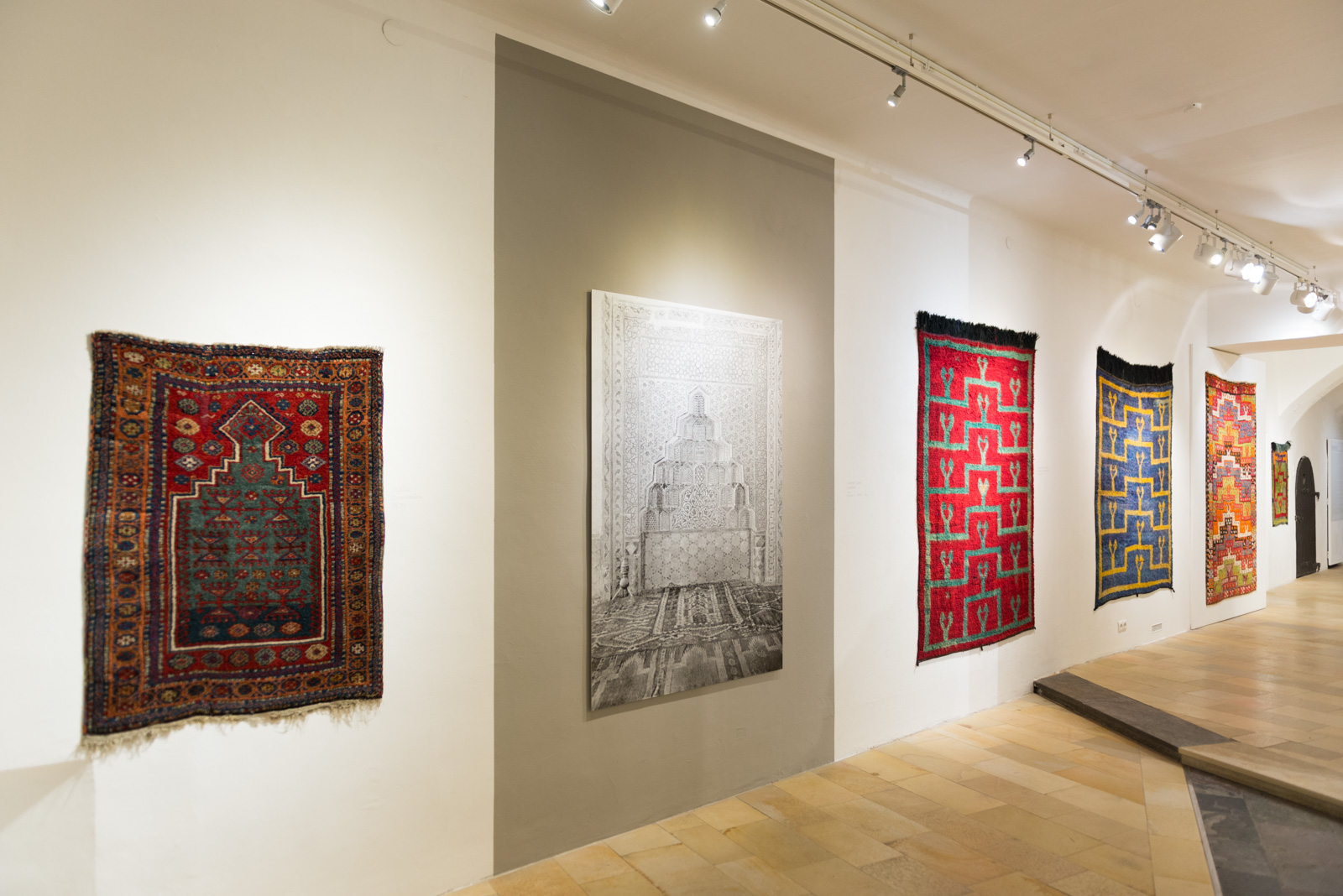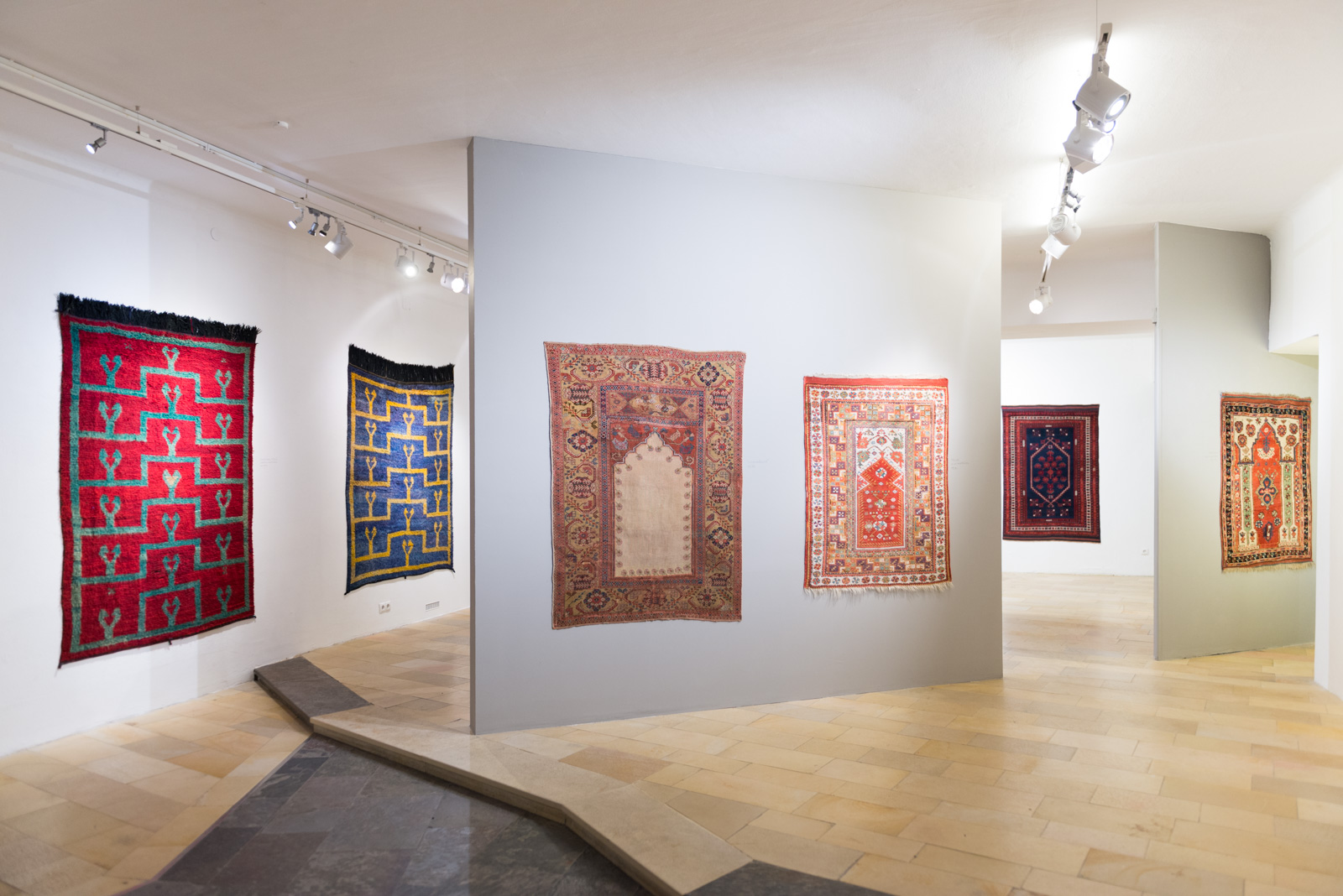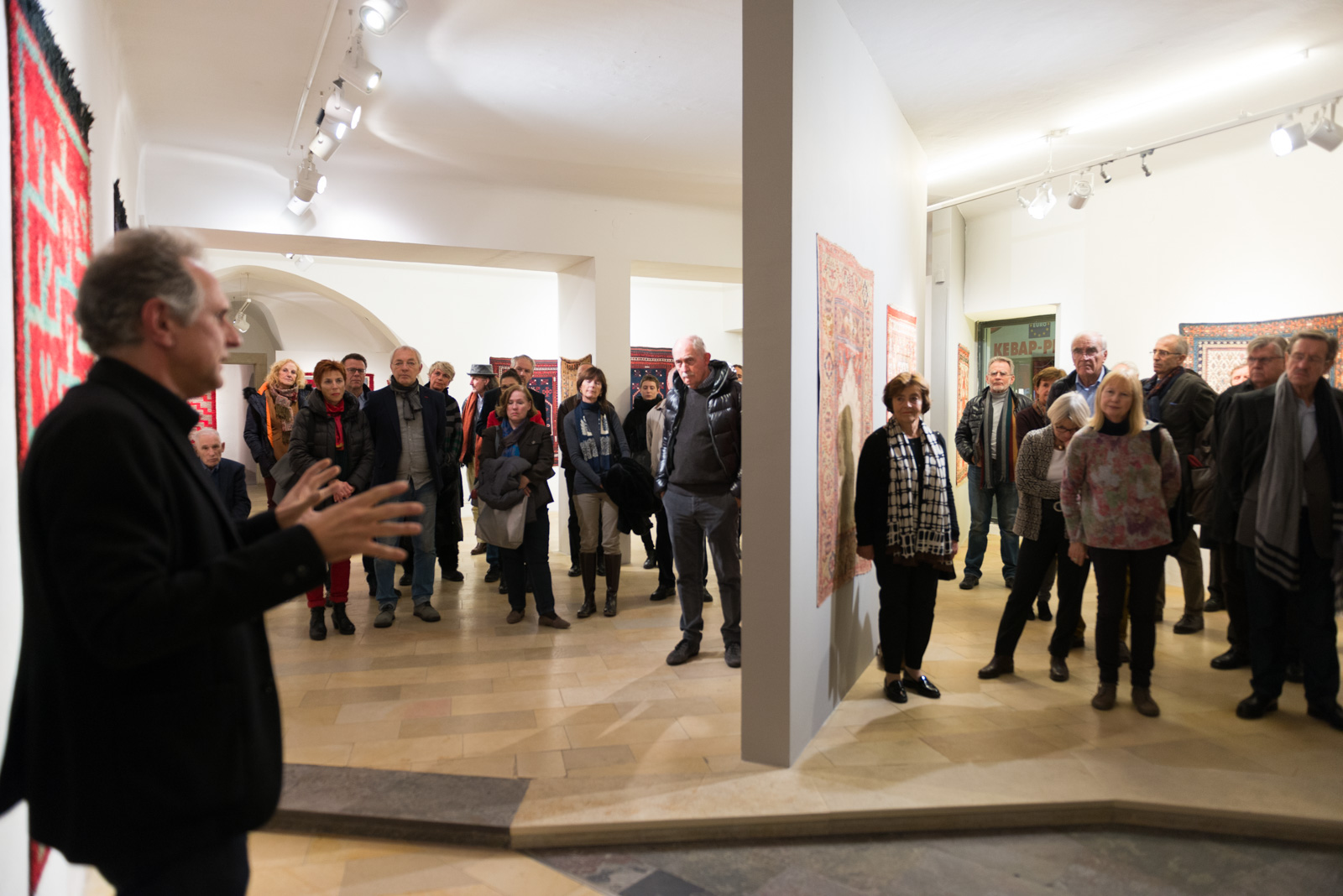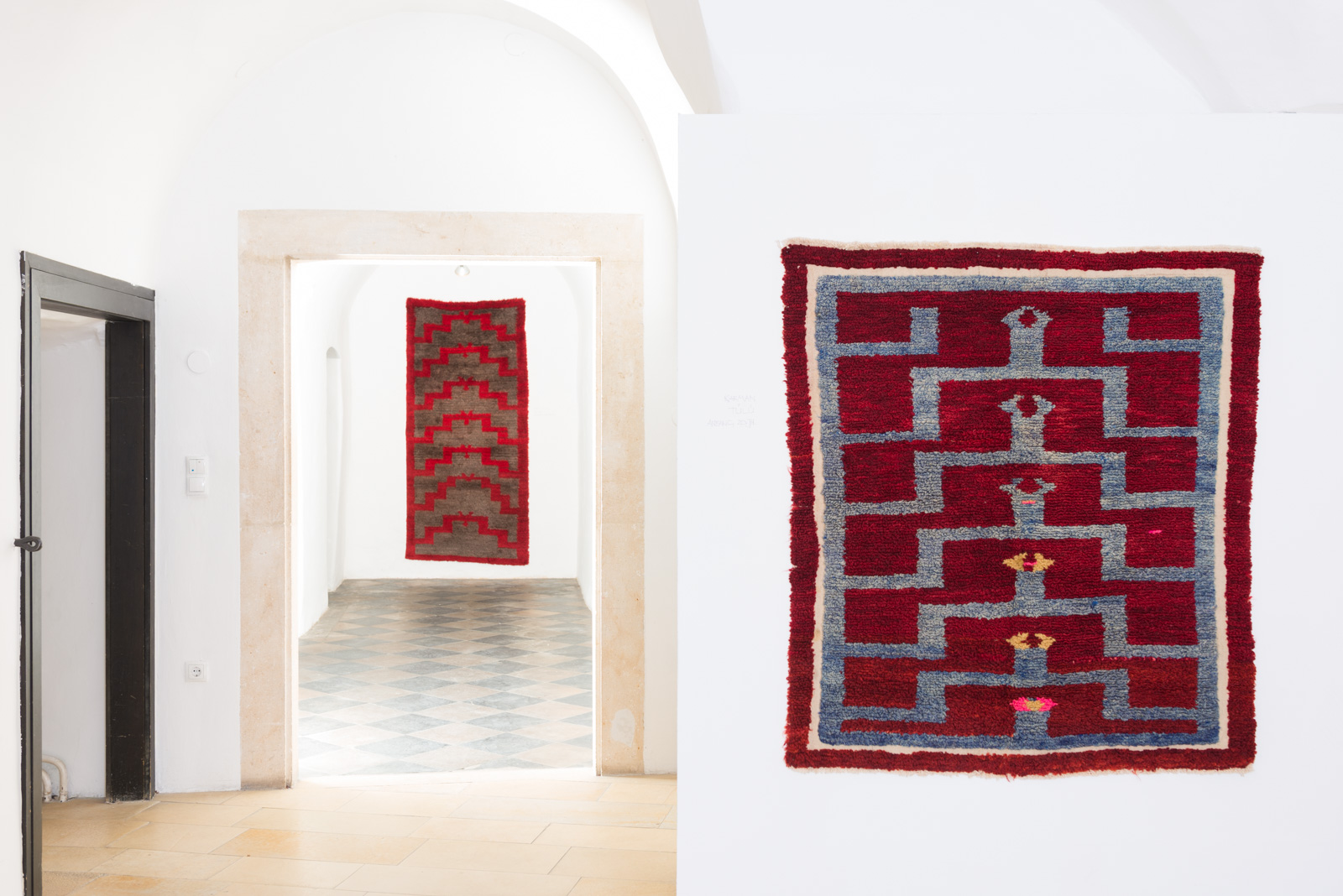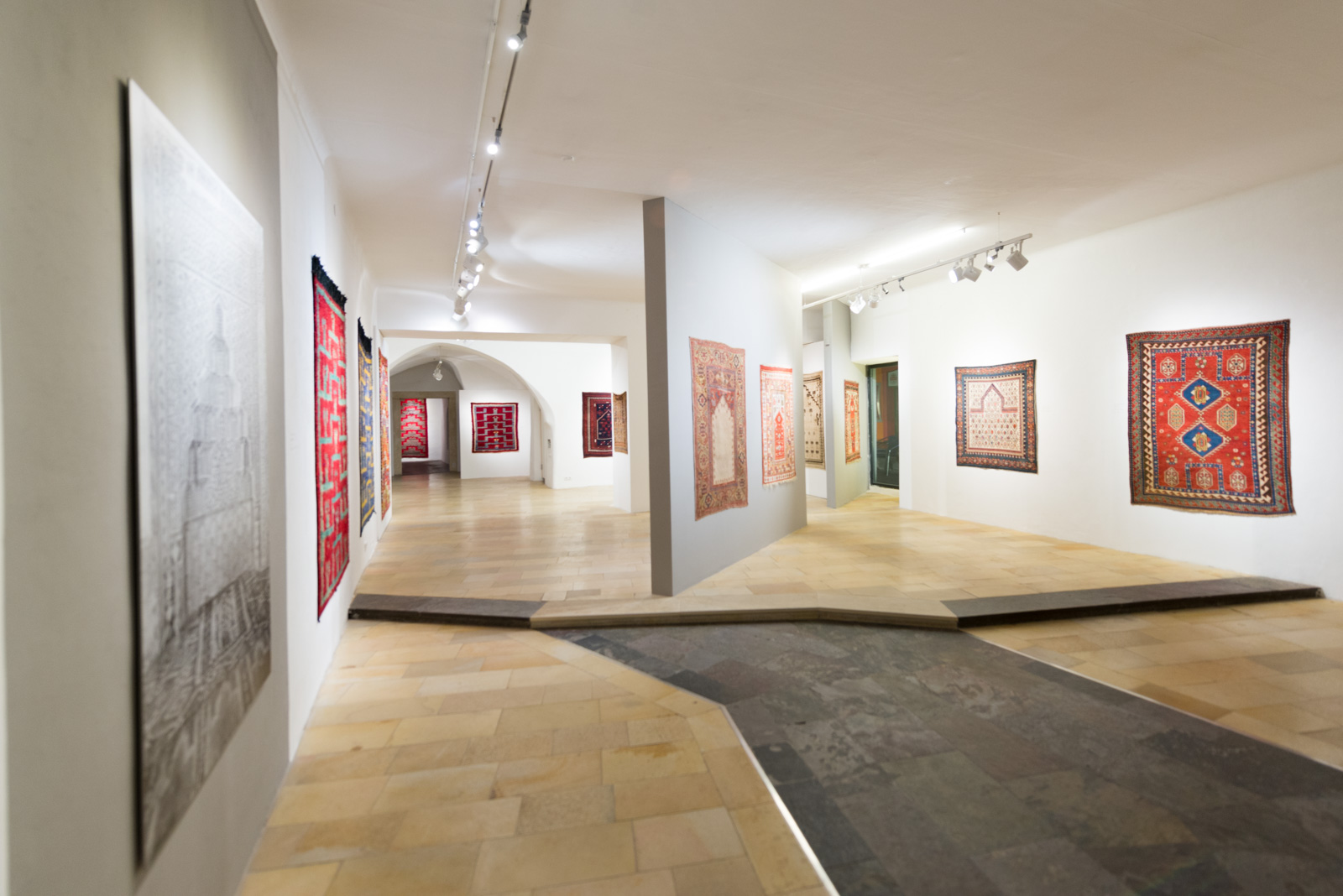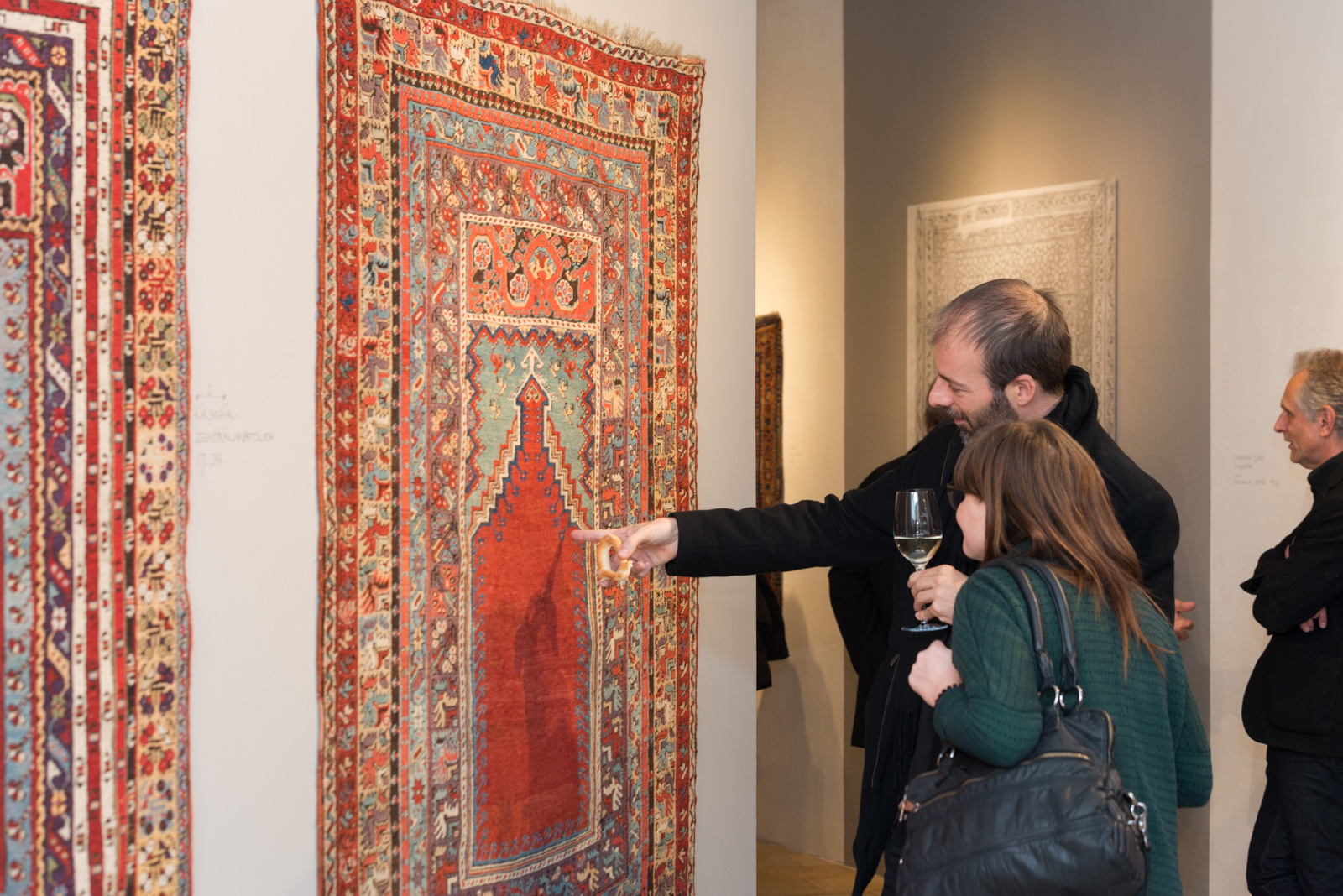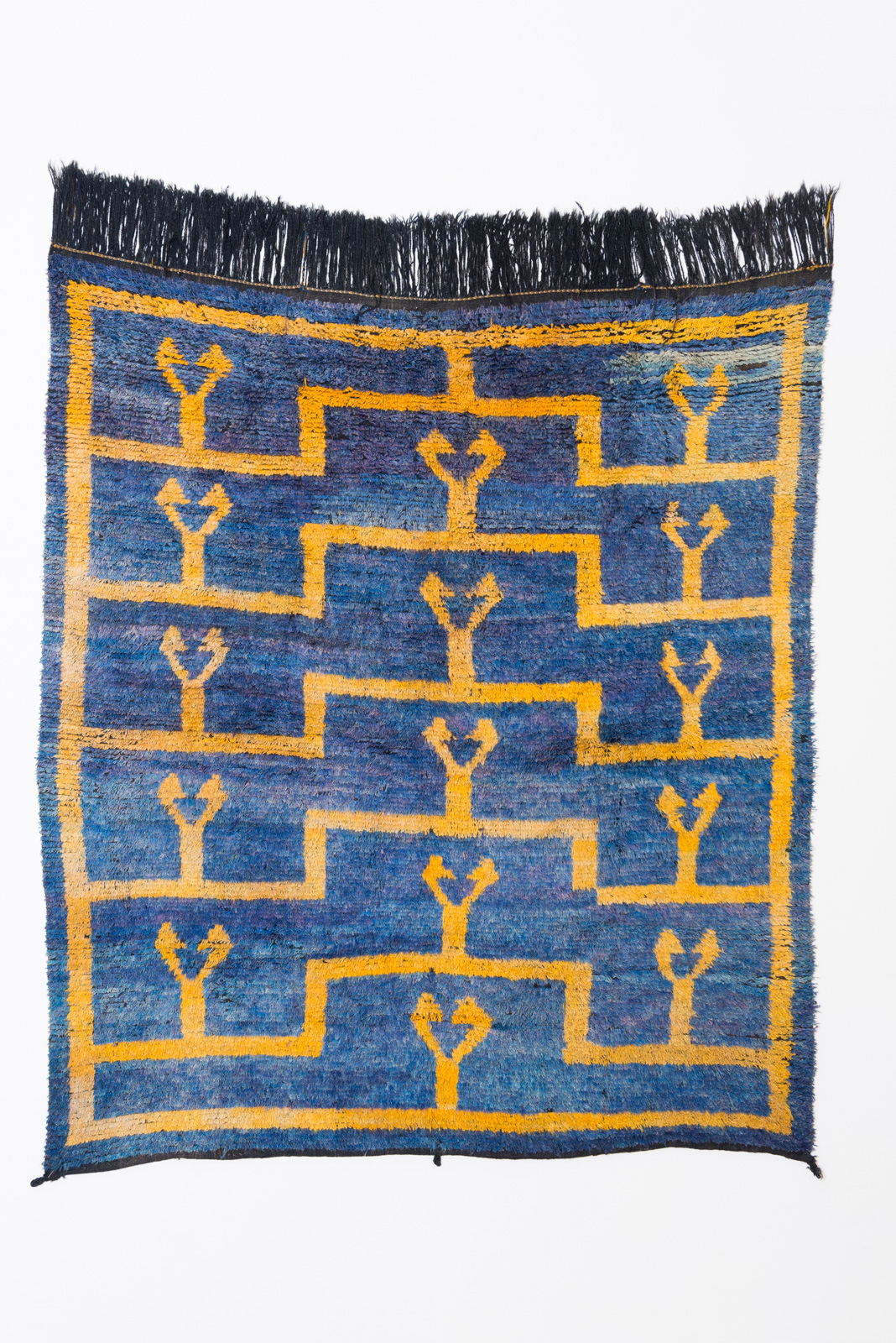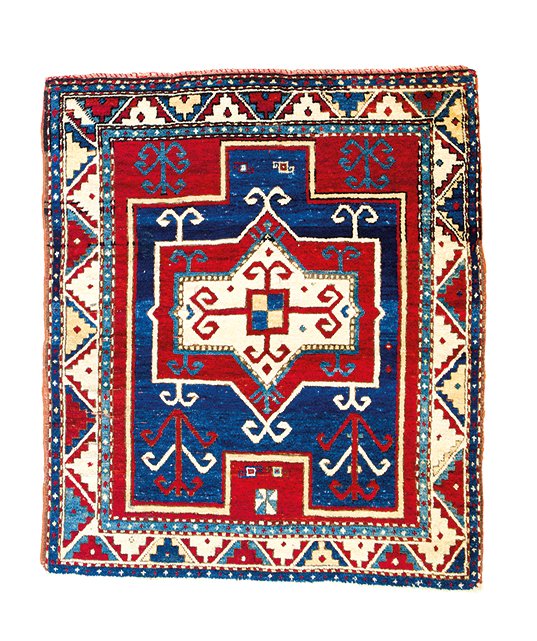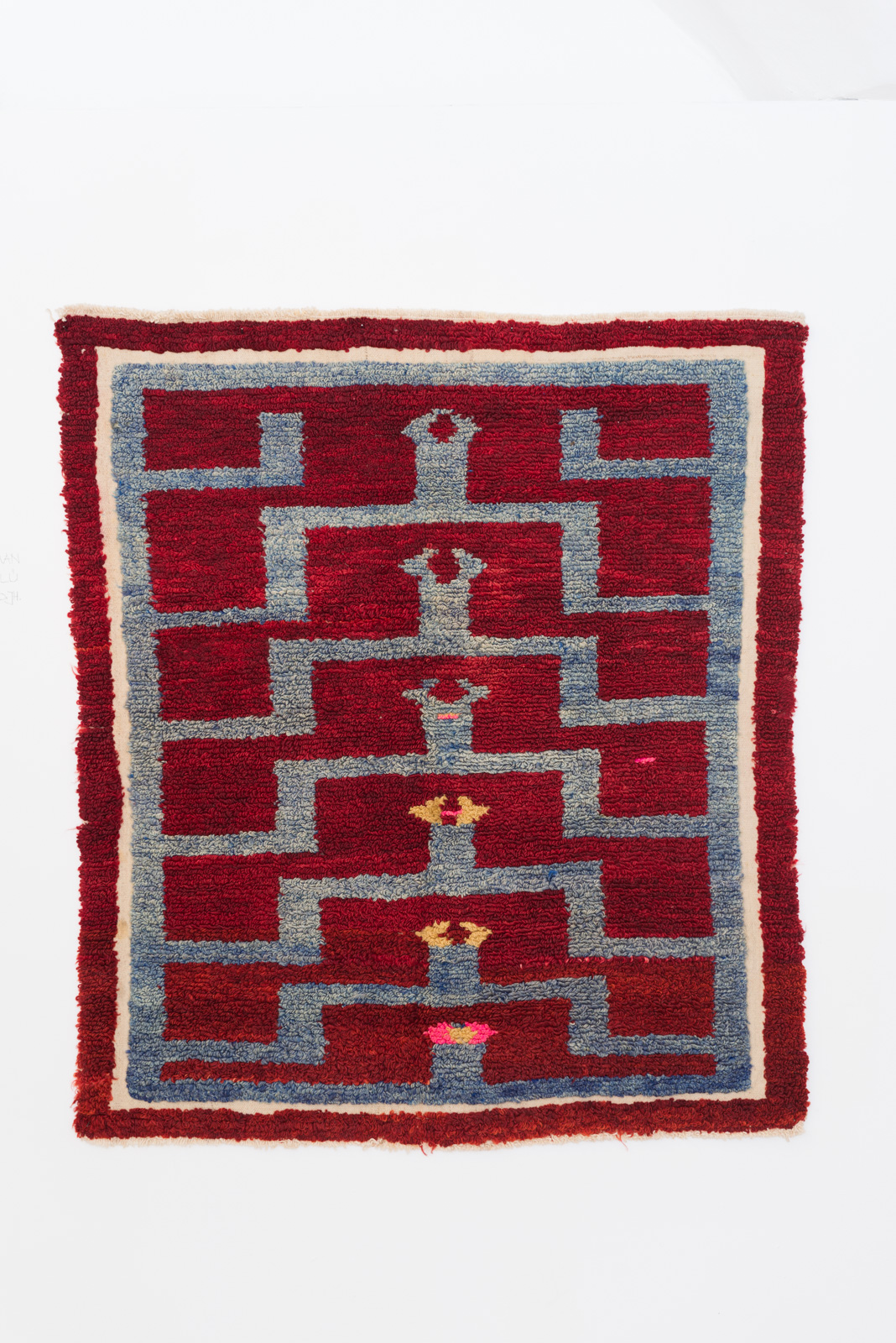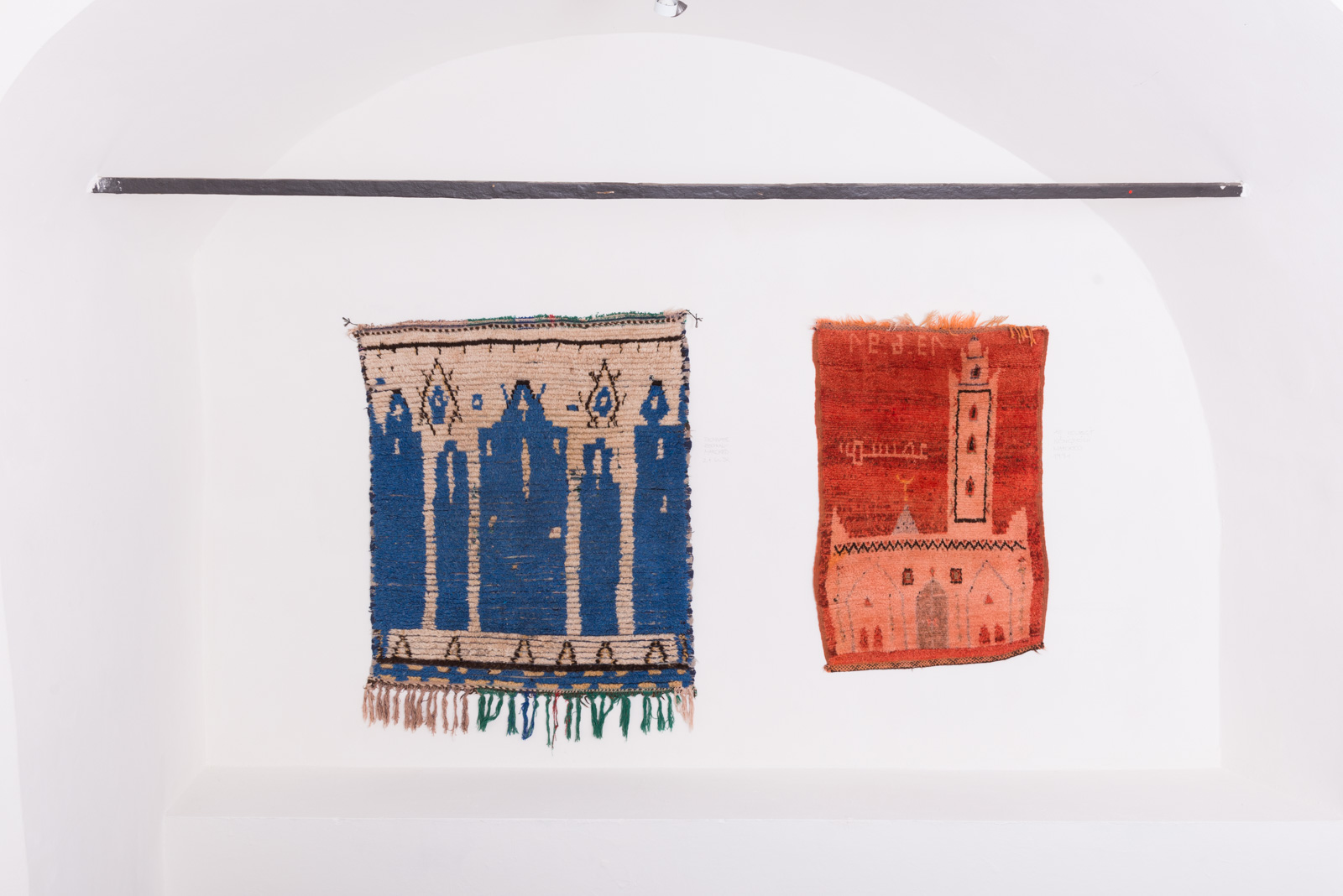Opening on monday, 28th of november 2016, 7PM
Introduction by Günther Holler-Schuster
Exhibition 29th of november – 22nd of december 2016
 The woven pieces that we now refer to as “prayer rugs” have been known and popular in Europe since the 17th century. Today these rugs can be found among numerous type designations such as Melas, Ladik, Yahyalı, Kula, Kırşehir, Mudjur and Gördes. From a Western perspective, these rugs can be easily categorised since they appear to be clearly defined and have very similar design elements in terms of their form and functionality. Yet this apparently limits the general multifunctionality of the rug by confining it to the religious and spiritual domain. After all, this spiritual level especially resonates in the Western reception of prayer rugs. As religious ritual objects, this type of rug is not merely decorative. Instead, the spiritual element can tend to be exaggerated. The dominant element that always appears in prayer rugs is a vertical form in the centre of the rug that usually tapers to a point towards the top. Typically, it is red, blue, yellow or green and accompanied by filler motifs, scatter motifs and borders. The greater part of the contextual and formal purpose is attributed to this element, which is equated with the mihrab, the holiest place in a mosque. The mihrab first became a special sanctuary in mosques in the early 8th century. Prior to that, people prayed outside without an underlay and there was no architectural equivalent. The mosque – particularly in its magnificent manifestations – emerged later on. Yet the tradition of the prayer niche did not begin with Islam and the building of mosques, but in fact has much older roots dating back to antiquity. As a result, no culture can lay sole claim to this universal architectural design element. According to the teachings of Islam, Allah appears to man as a shining light in a mihrab. One of the best-known verses of the Quran (Sura of Light 24:35) discusses this. In fact, we frequently see stylised lamps depicted in the mihrab niches of prayer rugs. In some cases, bouquets of flowers can serve this function, although technically they usually trace back to the tree of life motif, which of course grows best under Allah’s light in the prayer niche. Yet the prayer niche is also an acoustic instrument. Prayers to Allah echo in the niche form, thus allowing words of prayer to symbolically spread throughout the world. For devout Muslims, the mihrab is thus a place where the divine is revealed as light and word.
The woven pieces that we now refer to as “prayer rugs” have been known and popular in Europe since the 17th century. Today these rugs can be found among numerous type designations such as Melas, Ladik, Yahyalı, Kula, Kırşehir, Mudjur and Gördes. From a Western perspective, these rugs can be easily categorised since they appear to be clearly defined and have very similar design elements in terms of their form and functionality. Yet this apparently limits the general multifunctionality of the rug by confining it to the religious and spiritual domain. After all, this spiritual level especially resonates in the Western reception of prayer rugs. As religious ritual objects, this type of rug is not merely decorative. Instead, the spiritual element can tend to be exaggerated. The dominant element that always appears in prayer rugs is a vertical form in the centre of the rug that usually tapers to a point towards the top. Typically, it is red, blue, yellow or green and accompanied by filler motifs, scatter motifs and borders. The greater part of the contextual and formal purpose is attributed to this element, which is equated with the mihrab, the holiest place in a mosque. The mihrab first became a special sanctuary in mosques in the early 8th century. Prior to that, people prayed outside without an underlay and there was no architectural equivalent. The mosque – particularly in its magnificent manifestations – emerged later on. Yet the tradition of the prayer niche did not begin with Islam and the building of mosques, but in fact has much older roots dating back to antiquity. As a result, no culture can lay sole claim to this universal architectural design element. According to the teachings of Islam, Allah appears to man as a shining light in a mihrab. One of the best-known verses of the Quran (Sura of Light 24:35) discusses this. In fact, we frequently see stylised lamps depicted in the mihrab niches of prayer rugs. In some cases, bouquets of flowers can serve this function, although technically they usually trace back to the tree of life motif, which of course grows best under Allah’s light in the prayer niche. Yet the prayer niche is also an acoustic instrument. Prayers to Allah echo in the niche form, thus allowing words of prayer to symbolically spread throughout the world. For devout Muslims, the mihrab is thus a place where the divine is revealed as light and word.
Yet there are also other cultures in which the location of the divine and/or prayer is associated with a niche-like architectural element. In Christian churches, for example, similar significance is given to the apse, which is shaped like a large prayer niche and can be viewed as symbolising heaven. In Catholicism, the divine in the form of the host in the monstrance is stored in the tabernacle, which represents the centre of the altar. Here, too, one encounters God in the transformed form of the host.

The mihrab does not necessarily have to be the only architectural reference in this context. In some rugs, for example, theshape of the niche is reminiscent of the “head and shoulders” motif on Anatolian gravestones. In many cases, this may have to do with older burial rituals, in which kelims with such motifs were used as burial shrouds to wrap the dead. It is also worth taking a broader view of mosques in this context. Here one may recognise that the entire mosque compound – with its walls, gates, courtyards and prayer hall – can at times become part of a prayer rug’s formal examination. The large mosques commissioned by the Ottoman sultans, for example, can be viewed from this perspective – such as when multiple niche shapes are layered within one another, concentrically moving towards a centre, as it were. Based on their structure, the floor plans of these mosques consist of sections, strung together along the main axis and culminating in the mihrab. This creates the impression of nested portals. The character of the portal is yet another way to interpret the prayer rug. Numerous mosques, madrasas (Quran universities) and caravanserais (roadside inns) are preserved from the Seljuk and Ottoman periods, whose portals are charged with symbolism indicating a threshold to a different, possibly spiritual realm. These massive portals, embellished with stone carvings or ceramic tiles, such as those also found in the iwan (ivan) halls in mosques in Iran and Central Asia, emphasise the function of the transition between different spheres – symbolic doors to a transcendental world. One of the original ideas behind the niche is that it visually conveys to believers that they are stepping into a place of God’s mercy. This suggests the door to heaven as well as the idea of the “gate of divine wisdom” from Islamic mysticism. Similar to the iconographic “garden rug” of Persian origin, the prayer rug also involves a consolidation and transformation of reality. In one instance, the Islamic garden with its field design is elevated to a spiritual level as a metaphor for paradise and finds its visual equivalent in the rug. In the other, architecture becomes the starting point for a process of transformation.
The portal as a transition to the transcendental realm, the rug as a special place that bundles several functions. Rugs thus become places. They offer an original way to create flexible places in nomadic life. The key here is the transgression of image and sculpture towards the realm of artistic space. It can be argued that rugs – and not just prayer rugs – take on proto-architectural roles. After all, it was not in vain that Gottfried Semper, for example, has attempted to trace the idea of architecture back to a primeval textile world. The general artistic concept of rugs, which includes purpose and function, is clear in prayer rugs. The decorative design intent must be understood in connection with the rug’s multifunctionality. Prayer rugs can also only be understood in this symbiosis. An image, which can be entered like a place, connects the tactile and visual, and thus defies the Western notion of a separation between image and object.
It has already been emphasised that prayer rugs essentially represent a consolidation of architectural elements. It thus makes sense that Friedrich Sarre referenced several Seljuk mihrabs in 1909 in his book “Erzeugnisse islamischer Kunst” (“Works of Islamic Art”), including the prayer niche from the Laranda Mosque in present-day Karaman near Konya, built in 1258. Like many others, this mihrab has a stepped design with five niches, which recurs in many rugs. The stepped design leads to a multiplication of the mihrab motif on a small scale. In the rug, the multiplication of the niche reiterates the ornamental character, which can be likened to a process of abstraction. Stepped mihrab rugs thus become a special type of Anatolian prayer rug. The aforementioned abstraction of the strung-together niche design is later expressed in a particularly appealing way in tülüs, which were frequently produced in Karapınar / Central Anatolia and impress viewers with their simple and reduced canon of forms. In these rugs, minimalistic designs are usually executed in just two colours and are reduced to the linear form of the niche. By multiplying the niche motif, any notions of portals as well as of mihrab niches are broken up into graphic bar-like lines, thus leading to a high degree of abstraction.
Whereas we in the contemporary Western world usually understand the abstraction process as a reduction of concrete structures, in an Islamic context, the process is reversed. For the Islamic artist, the abstract play with geometric figures is generally a major priority. The Islamic artist uses ornamental components to connect the spiritual world with the sensual world – it essentially materialises the conceptual level. Geometric compositions thus become symbols and icons of the cosmic connections of creation, crystallisations of a kind of secret world order hidden behind the visible world. This idea is found in architecture as well as in rug art, ceramics, metalworking and woodcarving.
Other forms of artistic expression also seem to be based on breaking up the static block-like designs that are naturally found in architecture. The surfaces of walls are covered in decoration to create the lightness needed to abandon one’s rootedness in the earthly world in favour of the dematerialised sphere of the divine. The goal is to refine the senses to accept a higher reality. In order to do this, the architectural shell must discard its earthly gravity and become ethereal. Decoration makes this possible. For this reason, Islamic aesthetics by and large tend to avoid emphasising tectonic fundamental laws and static forces, which are typical in European architecture.
In the context of architecture, decoration consequently does not just have a competing, but also a supporting role. The idea seems to be to cancel each other out. A given shape is not meant to stand on its own and should make no conclusive statements. The appearance of spiritual order is to be rendered clearly here. The eternity of the cosmos is to be felt, momentarily, in the earthly realm.
As previously mentioned in the context of the Sura of Light, where Allah reveals himself in the dematerialised condition of light, a similar effect is pursued with regard to decoration. All material things are broken down in the decoration – dematerialised. The dematerialisation process escalates and leads to an abstraction process. Both reach a climax in the rug, which is ultimately the special place, the flexible place, and the consolidation of the spiritual in the material realm, as well as the visualisation of the word. It thus represents a formal transition – from architecture to textile or image. Yet its content also symbolically makes the rug a transition zone from the earthly to the otherworldly or paradisiacal.
Reinisch Contemporary gallery will be exhibiting select prayer rugs from Anatolia, the Caucasus and Morocco from 29 November to 22 December 2016. Despite the geographic distance between these regions, the rugs show remarkable parallels and, at the same time, highly different forms of expression in similar contexts. The believer is generally not obligated to say his prayers on a rug. The primal idea of someone kneeling in the dust to pray to Allah as well as the act of touching one’s forehead to the ground while praying – and thus being united with the earth and creation – would seem more obvious. Rugs, mats and animal hides only came to be used later and were initially mainly used indoors. Over time, special forms of praying developed that made the rug a central element of spiritual practice. Its formal passing on has led to the loss of its original function as a ritual object, and has, to this day, elicited many different forms of expression, turning the prayer rug into a prestigious item, which holds a fixed place in both Islamic and Western culture. Nevertheless, the reasons for its appreciation can be understood very differently. What is an image for some is still a “special place” for others – a transition from the earthly, material realm to a spiritual, religious dimension.
Günther Holler-Schuster

